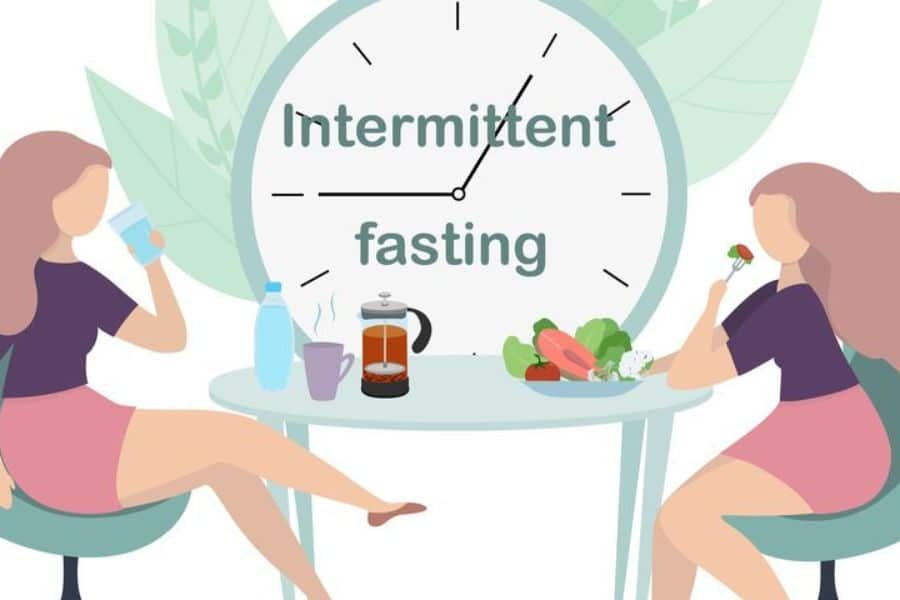Understanding Intermittent Fasting
Intermittent fasting for women is getting a lot of attention as a solid method for shedding pounds and boosting wellness. It’s all about mixing between eating and not eating, and your body could enjoy some perks from this dance.
Benefits of Intermittent Fasting
-
Weight Loss and Fat Reduction:
- This fasting style might match traditional diet plans for losing weight and trimming fat.
- It can feel more natural to stick with compared to other diets, making it a smart, long-term choice.
-
Improved Insulin Sensitivity:
- Taking regular breaks from food could make your body respond better to insulin. This balances your blood sugar, possibly lowering the risk of diabetes.
-
Cardiovascular Health:
- Fasting can cut down bad cholesterol and triglycerides, paving the way for a healthier heart.
-
Brain Health:
- Giving your stomach some downtime might help your brain by cutting inflammation, growing new nerve cells, and sharpening your thinking.
-
Cancer Prevention:
- New clues suggest that fasting could push back certain cancers and keep their risk factors at bay.
Check out more about these perks in our detailed article on intermittent fasting benefits.
Working Mechanism of Intermittent Fasting
How fasting works its magic: once your body gobbles up all your recent meal’s calories, it starts munching on fat instead through “metabolic switching”. Here’s how it breaks down:
- Glycogen Depletion:
- Right after eating, your body first burns glucose for fuel.
- Several hours without snacking (usually 12 plus hours in) leads to a sugar drop, and your liver’s glycogen stash gets tapped.
- Fat Burning:
- Once glycogen runs empty, your body starts burning fat to keep you going.
- This switch is where the magic happens for trimming down.
- Cellular Repair:
- Fasting triggers cells to tidy up and repair, tossing out worn parts.
- This cleanup boosts how well cells work overall.
- Hormone Optimization:
- Breaks from meals might tweak hormone levels, amping up fat burning and keeping muscles in check.
Your body needs time to get the memo. Mattson’s work shows adaptation could take two to four weeks, during which you might feel snacky or cranky (Johns Hopkins Medicine).
| Stage | Timeframe | Key Processes |
|---|---|---|
| Glycogen Depletion | 0-12 hours | Glucose burned for energy |
| Fat Burning | 12+ hours | Fat stores used up for energy |
| Cellular Repair | During fasting | Clean-up of damaged parts |
| Hormone Optimization | Adjustment period | Boosted growth hormone, better insulin & norepinephrine |
To get started on this eating style, you can peek at our guides on intermittent fasting for beginners and intermittent fasting schedule.
By getting how these processes work, you’ll see just how intermittent fasting can trim you down and give your health a nice hike.
Impact of Intermittent Fasting on Health
Intermittent fasting isn’t just about shedding pounds; it’s packed with perks for your health. By getting how it affects weight, insulin trouble, and your ticker, you can figure out if fasting fits your lifestyle.
Weight Loss and Body Fat Reduction
Fasting’s kinda like the superhero of dieting. It helps you lose weight and torch fat more effectively than standard diet plans. Some folks find it’s even easier to stick with.
| Diet Approach | Weight Loss (lbs) | Body Fat Reduction (%) |
|---|---|---|
| Intermittent Fasting | 8 – 10 | 3 – 7 |
| Traditional Calorie Restriction | 7 – 9 | 2 – 5 |
Think fasting might be your thing for trimming down? Check out our guide on intermittent fasting weight loss.
Effects on Insulin Resistance
Another big win with fasting is better insulin sensitivity. It helps your body handle sugar like a pro, which is especially awesome for keeping type 2 diabetes at bay and tackling insulin hiccups.
Boosting how your body deals with insulin can slash your risks for metabolic woes and boost your health game. Curious about how fasting shakes things up with insulin? Dive into this chat on intermittent fasting and metabolic health.
Cardiovascular Health Improvement
Fasting doesn’t just work its magic on your waistline; it’s great for heart health, too. By tweaking cholesterol, calming blood pressure, and cutting down inflammation, you can dodge heart-related issues.
| Health Metric | Improvement (%) |
|---|---|
| Cholesterol Levels | 10 – 15 |
| Blood Pressure | 8 – 12 |
| Inflammation Markers | 20 – 30 |
These boosts mean your heart’s in for a longer, happier run. For more on how fasting perks up heart health, nosedive into the intermittent fasting benefits for your ticker and spice up your routine for solid results.
By wrapping your head around these bits, you can make fasting work for your life and health goals. Tweak your fasting habits to what suits you best, and don’t forget to chat with health pros along the way. Want to sketch out a killer fasting plan? Don’t miss our guide on intermittent fasting meal plan.
Intermittent Fasting and Brain Health
Jumping on the intermittent fasting train could be your ticket to a sharper mind and a healthier brain. For those of you looking to give your brainpower a little boost without popping pills, shaking up your eating habits might just do the trick.
Loosening the Inflammation Grip
Did you know that skipping a few meals might actually calm your brain down? Intermittent fasting can reduce that pesky inflammation linked to diseases like Alzheimer’s and Parkinson’s. By putting the brakes on inflammation, you’re not only taking the edge off these diseases but also giving your brain a chance to breathe and function better.
Leveling Out Your Blood Sugar
Keeping your blood sugar from acting like a roller coaster is a big deal if you want to keep your brain at its best. Intermittent fasting is like the wise friend who helps balance it all out, reducing insulin hiccups and keeping that sugar in check. With stable blood sugar, you’re cruising through your day with more focus, better moods, and no post-lunch slumps.
Sprouting New Brain Cells
Here’s a head-scratcher for you: intermittent fasting might help you grow new nerve cells. Yep, that’s a real thing. It boosts the production of a protein called brain-derived neurotrophic factor (BDNF), which is like a growth serum for those brain cells (Medical News Today). Flexing your brain’s ability to adapt and form new paths can supercharge your learning and memory.
Sprinkling a bit of intermittent fasting into your life can work wonders for your brain’s well-being. Want more details? Peep our guide on fasting benefits. If you’re just starting, our beginner’s guide could be a handy compass. And, as always, chat with your doctor before making big changes to your diet, especially if you’ve got health stuff going on.
Potential Cancer Prevention
Let’s dive into how giving up snacks at certain times might keep cancer at bay. Here’s how skipped meals could put the brakes on tumor hustlers and slap cancer-causing factors in the face.
Delaying Tumor Onset
Skipping breakfast or dinner might not just be a diet trend—it could also keep pesky tumors at bay for longer. Some critter trials hint that grazing less might shrink the cancer risk by tapping the brakes on tumor development. This links back to how your body acts when it’s in “fast mode.”
When you skip meals, your body’s got this thing called autophagy. Basically, your inner cleanup crew comes alive and starts dealing with worn-out cells, even sorting out the ones up to no good, like potential cancer cells before they grow into mount doom. You can poke through more on this in our intermittent fasting and autophagy deep dive.
Reducing Cancer-Related Factors
Fasting doesn’t just drop the weight; it gives pesky stuff like insulin and inflammation a one-two punch, both of which have their sticky fingers in cancer’s cookie jar. High insulin can give a leg up to cancer cells, but skipping meals cuts down insulin levels, lowering your risk along the way.
Fasting gets your body into fix-it mode, easing chronic inflammation. That’s code for cutting down one sneaky cancer link.
| Factor | Intermittent Fasting Effect |
|---|---|
| Insulin Levels | Lower |
| Inflammation | Trim |
| Tumor Growth | Slow |
There’s lots more learning in the works, but early peeks show that meal skipping might just give cancer treatments like chemo a helping hand, minus some of the dreadful side effects (ZOE).
Understanding Intermittent fasting’s game against cancer might just help you decide if this diet gig is for you. Of course, chatting with your doc for tips shaped for your own health is golden. And if you’re curious about kicking off this fasting thing, our beginner’s guide to intermittent fasting is your new BFF.
Intermittent Fasting Plans
So you’re thinking about giving intermittent fasting a whirl? Awesome choice! Not only can it help you shed some pounds, but it can also boost your overall health. There are different flavors of fasting you can try, and each has its own playbook on when you chow down and when you catch a break. Let’s break down three well-known intermittent fasting approaches: Time-Restricted Eating, the 5:2 Method, and 16/8 Fasting.
Time-Restricted Eating
Time-Restricted Eating is all about squeezing your meals into a certain time slot every day, leaving the rest for fasting. Picture this: you munch between 10 a.m. and 6 p.m., and then let your stomach chill from 6 p.m. to 10 a.m. the next morning.
| Eating Hours | Fasting Time |
|---|---|
| 10 a.m. – 6 p.m. | 6 p.m. – 10 a.m. |
Think of it like giving your body the free pass to dive into its sugar stash and start torching fat once it runs out. It’s a super-easy-peasy way to kick off your intermittent fasting adventure and usually blends seamlessly into your routine. Check out our scoop on the perks of this plan in our write-up on intermittent fasting benefits.
5:2 Approach
The 5:2 way has you eating your regular stuff for five days, then hitting the brakes on the other two by seriously cutting down calories. On these fasting days, you’re looking at no more than 500 calories.
| Days | Food Intake |
|---|---|
| 5 Days | Regular meals |
| 2 Days | ≤ 500 calories |
It’s a bit of a step up from Time-Restricted Eating with the degree of difficulty, but you can choose which two days to lowball your calorie intake. It’s a solid game plan for whittling down the waistline and leveling up metabolic health. Need a helping hand? Peep our intermittent fasting meal plan for more direction.
16/8 Fasting
With the 16/8 Fasting gig, you chow down during an eight-hour window and fast the remaining 16. A fan-favorite schedule is eating between 12 p.m. and 8 p.m., then putting your appetite on pause from 8 p.m. to 12 p.m. the next day (Johns Hopkins Medicine).
| Eating Hours | Fasting Time |
|---|---|
| 12 p.m. – 8 p.m. | 8 p.m. – 12 p.m. |
This one triggers that magical metabolic switching—your body flips from burning sugar glycogen to fat. It’s no sweat for managing weight and giving your health a turbo boost. Snag more handy tips in our intermittent fasting for beginners section.
Each intermittent fasting plan has its own set of perks and can be tweaked to match your style and wellness goals. Make sure to chat with your healthcare provider before diving into any new eating routine, especially if you’ve got any health concerns lurking. For more deets, browse our pages on intermittent fasting results and getting fit while fasting.
Considerations for Women
Health Risks and Tips
Jumping into intermittent fasting (IF) without knowing the ropes might have some surprises, especially for women. It’s not all rainbows and butterflies; if you’re thinking of giving it a shot, take this slow – especially if you’re already dealing with stuff like diabetes, meds that are part of your routine, or if you’re pregnant or nursing. Chatting with your doc is key before diving into the IF pool (ZOE). There’s some digging into how IF mingles with cancer treatments, brainy issues, and other medical puzzles too.
Shedding Pounds
Looking to swerve into the weight loss lane? IF might just be your copilot. In fact, gals over 60 who stuck to a 16/8 daily IF grind trimmed an average of 2 kg (that’s around 4.5 pounds) in just 6 weeks! Plus, people doing an every-other-day fast thing showed weight loss of about 5-6% over 8-12 weeks, with belts cinching tighter. More juicy tidbits on dropping pounds with fasting are up for grabs in our weight loss and fat loss reads.
| Age Bracket | Pounds Dropped (kg) | Waist Snip (cm) | How Long? |
|---|---|---|---|
| Women 60+ | 2kg | N/A | 6 weeks |
| General (Overweight) | 5-6% weight | 5-7 cm | 8-12 weeks |
Love and Hormones
The romance between fasting and your body isn’t all smooth sailing. For women aiming to have kids, it can shake things up. Some find IF helps keep hormones in check and periods coming like clockwork. Others? Not so much. Their cycles might play hide and seek. Going easy and steady with IF can help dodge these hiccups (ZOE). If you’ve got particular reproductive issues, throwing a line to your health pro is a wise move. Seeking more wisdom? Peep our tidbits on IF perks and IF outcomes.
Remember, intermittent fasting is more than a temporary habit change—it’s a long-term shift. By weighing these considerations specific to women, you’re setting yourself up for a healthier trip on the IF express, riding towards not just weight loss but also overall better health! Check out our exercise and fasting resources for an added edge.










